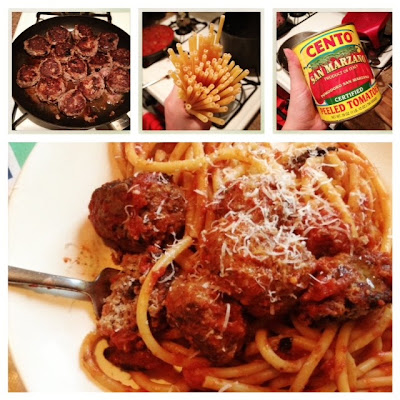It all started a few months ago when my husband and I decided to join 3 other million viewers and watch "Sugar: The Bitter Truth", the lecture in which UCSF endocrinologist Robert Lustig very convincingly explains why sugar, in the form of fructose, is pure evil. I soon went through my already HFCS-free pantry, and eliminated (= threw away or swallowed whole) all products containing sugar.* Of course, we realized we needed to find a type of bread without sugar. For sliced bread, we are now spending ridiculous amounts of money on Ezekiel sprouted bread, so I decided to research an easy bread recipe to bake a sugar-free loaf at home.
I started researching Italian blogs because, as far as I know, sugar isn't yet an ingredient in our everyday bread. I found this very simple recipe from ButtaLaPasta that not only does not require a bread machine, but it also allows you to use store-bought yeast rather than homemade starter yeast.** I know expert bakers will scoff at this, but I'm just learning. Just like I would not pick Lady D.'s wedding dress as my first sewing project, I will not choose a French baguette as my first bread-making experiment.
Anyway, here is the recipe. I kept the ingredients and rising times from the Italian blog, but then used the Dutch-oven baking method popularized by Mark Bittman and brilliantly explained by Patrick Lynch on his website (here). I hope you like it.
CHICKPEA BREAD
8oz cooked chickpeas (a small can will do)
1 packet active dry yeast
2 tsp salt
2 tbsp extra-virgin olive oil
lukewarm water
- Activate the yeast in 1/4 cup lukewarm water for 15 minutes.
- Mash the chickpeas with a fork.
- Mix the dry ingredients and then add the wet ingredients, kneading and adding lukewarm water until the dough comes into a ball and it is a little sticky and not too hard. If you're using a stand mixer, this should take a couple of minutes.
- Place dough into a large bowl, cover with a towel, and let it rise for 3 hours away from drafts.
- Knead the dough again for a couple of minutes (the dough will deflate), cut a cross on top of it, and place it on oiled parchment paper and then inside a large bowl. Let the dough rise for 1 hour.
- Forty minutes before the end of the final rise, turn on the oven to 425F and place a large Dutch oven, with cover, inside.
- At the end of the 40 minutes, carefully place the dough inside the Dutch oven with the parchment paper. Bake for 15 minutes with the pot cover on, and then for 20-30 minutes without, until the crust is nicely browned.
- Take bread out of the pan and let cool on a rack for about 30 minutes.
I made this bread a few times now, and I've been very happy with it. It is very quick to make, although you have to plan around rising and baking times. The result is a very soft, moist bread, and the Dutch-oven method gives it a crispy crust that I've never obtained by cooking bread in a regular oven. The chickpeas contribute a slight sweetness and add a good amount of fiber for what would otherwise be just white bread. One loaf lasts us two days, because really we are never happy with only one slice.
Let me know if you try it and if you have some suggestions. As I said before, I know nothing about bread making, so kneading times and techniques have all been improvised.
*With the exception of a chocolate salami purchased in Venice during my latest vacation. Yes, chocolate salami. It's a chocolate dessert that looks like a salami, and it's every Italian child's favorite thing in life. See one here.
**In Italy especially, there's a very powerful cult of bakers who create and feed their baking yeast at home. They call it Mother Yeast, and that's all I have to say.





